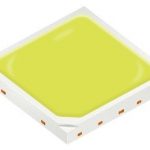
Operators of greenhouses and so-called indoor farms naturally want to be as energy-efficient as possible in addition to maximizing yields and ams-Osram’s Osconiq S 5050 addresses a key problem of often used white LEDs resulting in lower energy costs and more efficient lighting to luminaire manufacturers and indoor farmers.
In indoor farming, red and blue or alternatively red and white LEDs are the predominate com-binations found today.
Standard white LEDs used to grow plants also emit light in the red wavelength range, which could be covered by direct emitting red LEDs in the lighting system instead.
In addition, classic white LEDs require considerably more energy than a directly red-emitting LED would for a comparable number of red photons.
“Our new Osconiq S 5050 now enables a higher system efficacy of red-white spectra by reducing the share of phosphor converted red photons,” says ams-Osram’s explains Thomas Grebner.
The special phosphor used in the Osconiq S 5050 cuts the red part of the spectrum, so to speak. The red component in the white light of the LED is therefore considerably lower.
The Osconiq S 5050 enables compact luminaire designs for manufacturers thanks to its space-saving dimensions of just 5.0 mm x 5.0 mm x 0.7 mm.
The mid-power LED also boasts an efficiency of 2.86 µmol/J and an optical output of 630 mW. In addition, the device, which can be operated in a range of 180 to 1050 mA depending on the target application, is protected against overvoltages of up to 8 kV.